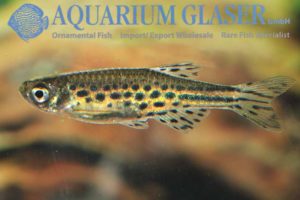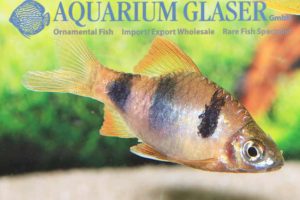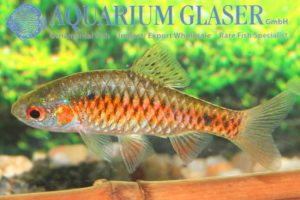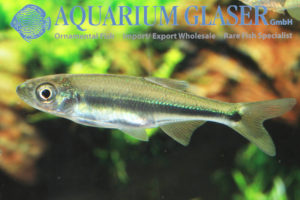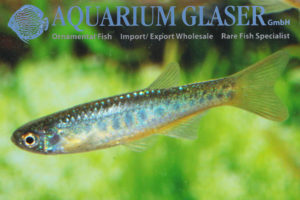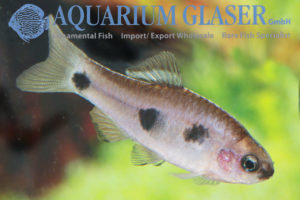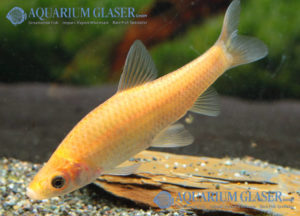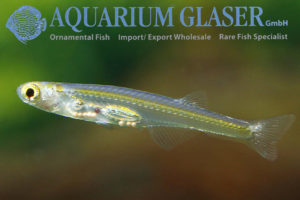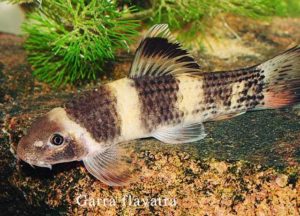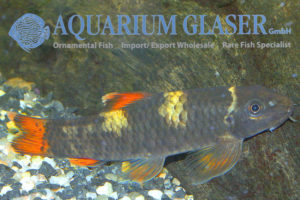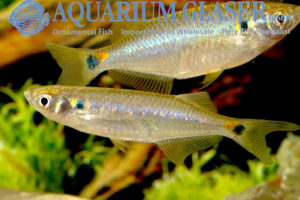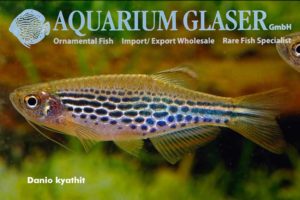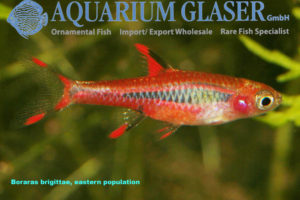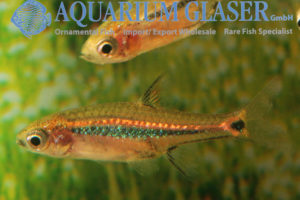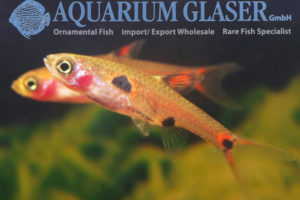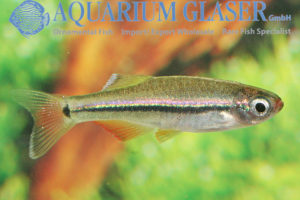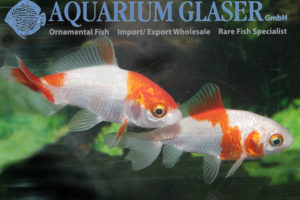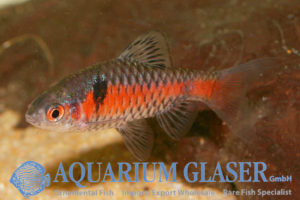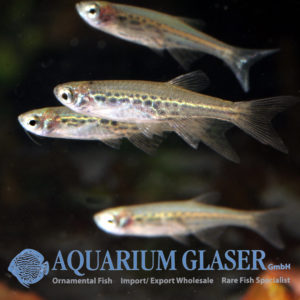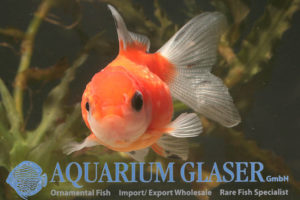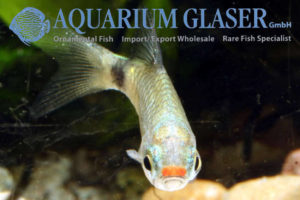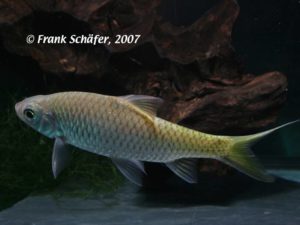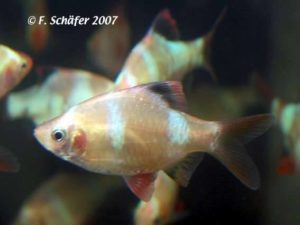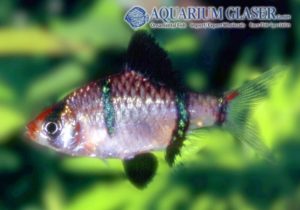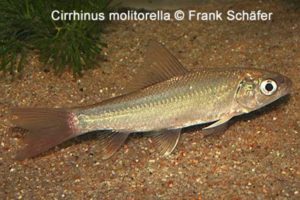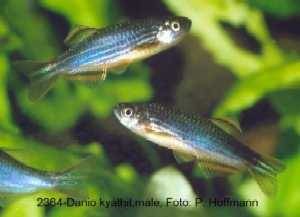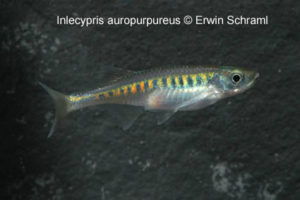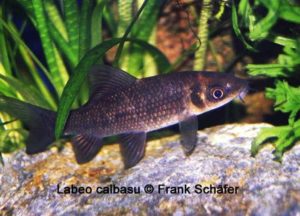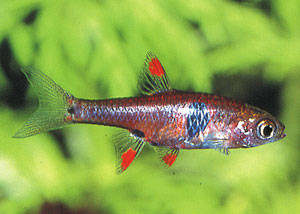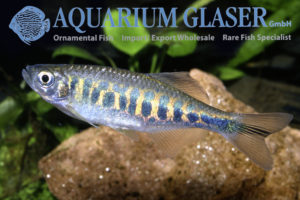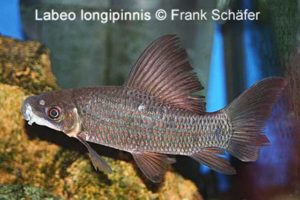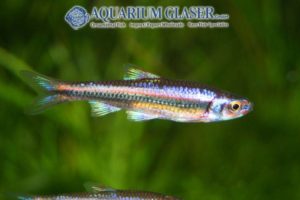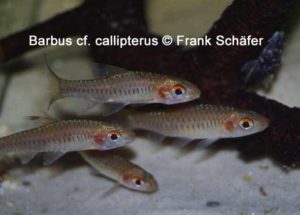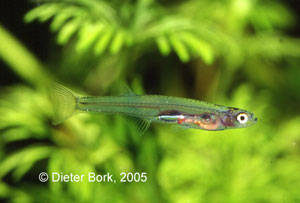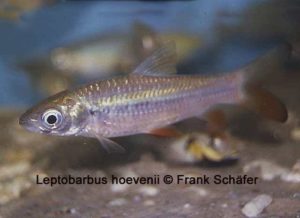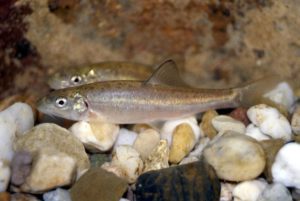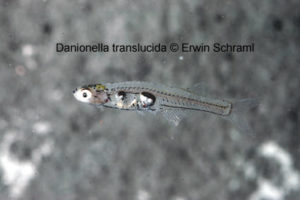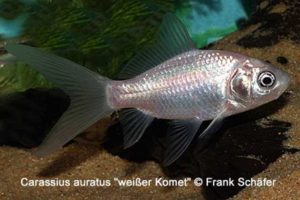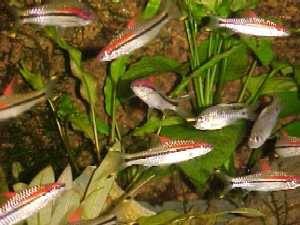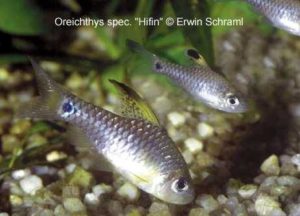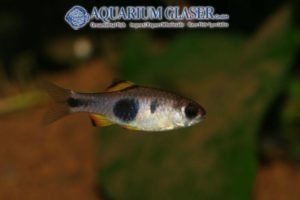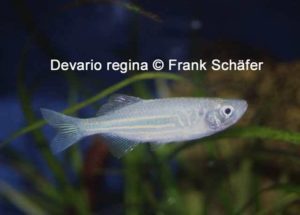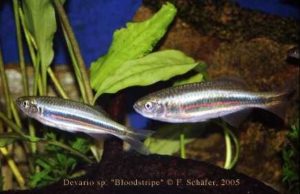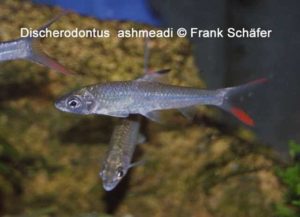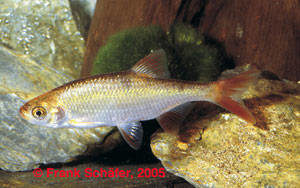Code: 413692
08. Carp like fishes (2): Barbs, minnows, carps, goldfish etc. (255)
-
-
Barbus narayani
This extraordinary barb originates from the South of India. It is a very close relative to the well known Black Ruby Barb (Barbus nigrofasciatus) from the nearby island of Sri Lanka, from which it differs mainly by coloration. What makes B. narayani so attractive is the unique lilac-blue hue that is shining on the body […]
-
Barbus manipurensis
Many species of Indian barbs belong to the most popular ornatmental fish at all. This is due to their brillant colours, the peacefulness and the easy keeping of these fish. A new species – Barbus manipurensis, which we can offer currently – has the potential to become also such a evergreen. The fish has been […]
-
Candidia barbata
Code number: 408003 Photo: Frank Schäfer
-
Danio aesculapii
Back in 2005 we were able to import this pretty species from Burma for the first time. This appeared under the provisional trade name Danio sp. “Pantherinus” (see http://www.aquariumglaser.de/en/danio-sp-pantherinus-_de_699.html). In 2009 the species was formally described as Danio aesculapii. It was named after the ancient Greek god of medicine, whose regalia were a stick with […]
-
Barbus candens
Three very similar species of dwarfish barbs occur in the central Congo basin. All of them become only 3-4 cm long. Additional forms are already known, but not researched scientifically yet. The three described species are B. candens, B. hulstaerti, and B. papilio. They live in shadowy brooks that have a acidic (pH 5.0 – […]
-
Pseudorasbora parva GOLD
For the first time we have a golden sport (the scientific word for that phenomenon is xanthoristic) of the Stone moroko (Pseudorasbora parva) in stock. Like all our garden pond fish the specimens are bred ones. The Stone moroko originates from Asia, where it occurs naturally in the northeastern parts (former USSR, China, Japan, etc.). […]
-
Danionella dracula
Danionella are extremely small cyprinids, which never grow larger than 2 cm. The species that was discovered first – Danionella translucida – was thought to be the smallest cyprinid in the world, until the even smaller genus Paedocypris was discovered. Currently, four species are recognized by science, three from Burma and one from northern India. […]
-
Garra flavatra
Now available again! We are pleased to be able to offer you Garra flavatra. Their attractive pattern as well as their reddish fins make it the most beautiful Garra species. In our first news (see news v. 16.12.05) it was offered under the trade name Garra spec. “Panda”, in the meantime resulted the species affiliation […]
-
Garra flavatra
The algae-eating suckermouth barb Garra flavatra from Burma is a quite beautiful fish. In contrast to all other species of algae-eaters this is a species which is kept due to its own attractivity. In our show-room the fish now revealed a secret they kept so far: they develope deep red fins! Keeping Garra flavatra is […]
-
Chela laubuca
Currently we offer a beautiful surface dwelling fish for community tanks for fishes from Asia: Chela laubuca. The absolutely peaceful species attains a total length of around 6 (rarely 8) cm. Keeping and breeding is comparable to that of the zebrafish (Danio rerio) which shares the same habitats as Chela laubuca in nature. Text & […]
-
Danio kyathit, D. quagga, and D. frankei
The zebrafish, Danio rerio, is one of the best known lifeforms of this planet and an important subject of scientific research. The beautiful fish is also one of the most popular aquarium fishes of the world. It is native in the river systems of the Ganges and the Brahmaputra in India. Ten years ago […]
-
Boraras brigittae & Boraras merah
Dieter Vogt described in 1978 a subspecies of Rasbora urophthalma (please see the entry for Boraras urophthalmoides in our fisharchives) from Borneo. He named the fish Rasbora urophthalma brigittae, a dedication name in honour for his wife Brigitte. The German name is „mosquito rasbora“. This is not because the fish are as tiny as mosquitos […]
-
Boraras urophthalmoides (formerly Rasbora urophthalma)
As early as 1914 the then very prominent German aquarist J. P. Arnold illustrated a new species of Rasbora in a German aquarium magazine, imported by the company Scholze & Pötzsche and said to be imported from Sumatra. In 1922 E. Ahl from Berlin Museum described this species scientifically as Rasbora urophthalma and since these […]
-
Boraras maculatus
The Dwarf rasbora (Boraras maculatus, formerly known as Rasbora maculata) is the species of genus Boraras (which currently comprises five species, all of them will become presented in the upcoming days) that is known for the longest time in the hobby. None of these species grows bigger than 2-3 cm and thus they are perfect […]
-
Tanichthys micagemmae – Jewel minnow
Currently two species f the genus Tanichthys are known in the hobby: the White Cloud Mountain minnow Tanichthys albonubes, and the Jewel Minnow, T. micagemmae. The White Cloud is available exclusively as bred specimens, wheras the Jewel minnows is also imported as wild collected fish. The Jewel minnow has been discovered in 2001 in Central […]
-
Wakin Hoe Kim
Goldfish are timeless classics. The number of different sports and colours seems to be neverending. Basicly all goldfish belong to the very same species, eg Carassius auratus. So every single sport is a mere variety and all the different goldfish can be crossed with each other. Most of the varieties that exist nowadays have a […]
-
The Odessa barb has finally been named: Pethia padamya
There is a good number of well known aquarium fish that bear no scientific name, so they „officially” do not exist at all! Only with a formal scientific description a name can be applied to a species that is binding for every person in the world. On the other hand, common names can be given […]
-
Danio sp. Panther
The smallest species of Danio known so far was now imported by Aquarium Glaser after some time again from Burma. The species is termed Danio sp. “Panther”, as it is not described scientifically yet. It becomes only 2-3 cm long. It is a schooling species that fits perfectly to smaller aquaria. Temperature should be chosen […]
-
Pearlscale
The goldfish is the eldest ornamental fish species in the world. For hundreds of years it has been bred on highest levels. Although the western aquarium hobby is unthinkable without the goldfish and its varieties the main breeding centres are still located in the east of Asia. It is very important to know where a […]
-
Barbus erythromycter – Lipstick barb
The males of this unique dwarf barb (maximum size around 4 cm) have a red “walrus moustache”. Until the scientific description of the species in 2008 it was known in the trade as Barbus cf. puntio. Text & Photos: Frank Schäfer
-
Poropuntius laoensis
(19.Dec.2007) For the first time Aquarium Glaser was able to import this barb, which is sized 20-25cm and which is quite unnoticeable at first sight. It usually residents in clear wood bourns in the catchment area of the huge Mekong River. The peaceful animals turn out to be very colourful, if you look closely. Especially […]
-
3 new varieties of Barbus tetrazona
Since last week we can supply 3 new breedingforms of the Tiger-Barb. They are called gold-green-stripe: albino-platinum: and green-platinum: From now we will have those on a regular base in stock.
-
Barbus (Puntius) tetrazona BLACKFIN
We got them! For the FIRST time in europe we have a small amount of german bred “Black Finned Tiger Barbs” (Kapuas area)in stock! This is the REAL Puntius tetrazona. In 2006, a privat hobbyist imported 8 pieces of this species. Mr. Dieter Bork bred a a small amount for us, which is actually available. […]
-
Cirrhinus molitorella
If you are interested in a larger growing fish, the mud carp Cirrhinus molitorella originating from Southeast Asia, could be the right thing for you. In the list of fishing world records it is quoted with a length by 1 m and applies in Thailand under the name Pa Keng as a strong fighter at […]
-
Danio kyathit
The Burma-leopard-Danio, Danio kyathit, (“Kyathit”, burmese for leopard) belongs to the many minnows, which came to Europe in a bigger number of pieces lately. We first saw this beautiful “new” Danio in the beginning of 2002 at AQUARIUM GLASER. In contrast to Danio rerio Daniokyathit is much more colourful. Both sexes show intensive orange-red, beautifully […]
-
Inlecypris auropurpureus
Inlecypris auropurpureus belongs to in Inlé lake in Myanmar occurring endemic fish species. That about 6 cm long becoming swarm fish should be held in well planted to not too small (80cm) tanks. Since they are good jumpers, young animals of 1,5cm length can already jump over 10cm high, the tanks have to be completely […]
-
Labeo barbatus
As a further new import from the Congo we can present you Labeo barbatus. It is a about 60 cm growing representative of the genus Labeo, which is represented in the Congo River with at least 34 species. In its habitat it lives in sections with strongly flowing waters. About its behaviour in aquaria little […]
-
Labeo calbasu
Labeo calbasu the Orange-fin shark is a real king sized labeo. In its homeland (Pakistan, India, Bangladesh, Myanmar, Nepal, Thailand and South West China) it is a fish for consumption and therefore of importance in the asiatic aquaculture. With a size of up to 1m it is not a fish for the “normal” aquarium. Aficionados […]
-
Boraras cf. micros
THE SPECIES HAS BEEN DESCRIBED SCIENTIFICALLY IN THE MEANTIME UNDER THE NAME OF BORARAS NAEVUS. PLEASE CHECK THE FOLLOWING PAGE: http://www.aquariumglaser.de/en/boraras-naevus_de_1397.html This scientifically undescribed dwarf fish was imported from Singapore. They have very bright coloration and will not outgrow 1.5 cm in length. Like all Boraras dwarfs these fish need a special aquarium on their […]
-
Devario pathirana
We received this endemic kind, which was only specified in the late 1980s, from Sri Lanka. Devario (formerly: Danio) pathirana exclusively occurs in a small area in Sri Lanka. Their final size is 8cm, they are easy to keep and their breeding is no problem either. This species is as demanding as the far […]
-
Labeo longipinnis
december 2005: For the first time in Europe we can present Labeo longipinnis from the Congo River to you. This about 30 cm long growing Labeo is not noticeable by a particularly spectacular design or colour. Due to its lively manner, beautiful form and fins it can become nevertheless a genuine “eye-catcher” in the community […]
-
Notropis chrosomus
(21.Jan.2008) Rainbow Shiner, that is what they are called! We have this dream in limited numbers available. They are really easy to keep and grows up to 6cm. They do not demand special water conditions, but they should be kept in water which is rich of oxygen. Their origin is Northamerica. You can find them […]
-
Barbus cf. callipterus
This strongly at Barbus callipterus reminding barb reached us from the tropical west Africa. Whether it is a variant of the Clipper barb B. callipterus or a near related species could yet not be clarified. The further information refers to the general maintenance conditions of bigger barb species.They are social swarm fish, which should be […]
-
Danionella aff. Mirifica
This species is the smallest representative of the carp family. It length does not exceed 1.5 cm. This fish comes from Myanmar (former Burma) and is imported only rarely. It is a typical shoaling fish and apparently lives in nature in large formations. Male fish attract the females for mating with clear croaking noises. These […]
-
Labiobarbus leptocheila
Labiobarbus leptocheila is a up to 30 cm long barb originating from Southeast Asia. There it is found from the Mekong area over the Malayan peninsula to Java, Sumatra and Borneo. Typically for the genus Labiobarbus is the protracted dorsal fin, as well as through black marks on the scales formed longitudinal stripes. In their […]
-
Leptobarbus hoevenii
Leptobarbus hoevenii the Cigar Shark or Mad Barb is a giant within the barbs. With a length of approx. 1 m and a weight of up to 10 kg the Cigar Shark already places a very special requirement: It needs a lot of space. For the maintenance of adults one should own a tank of […]
-
Barbus barbus
This endemic species can be found through Europe, from France to the Memel River, in England in the Thames and a few other rivers and in the Danube and its tributaries. During the breeding season the male fish have a cloudy secrete on the head with white nodules. The females are considerable bigger and rounder […]
-
Barbus congicus
The Congo Barb is a rarely traded ornamental fish. As you can see by their name Barbus congicus originates from the Congo river in Central Africa. With a length of 7 – 8 cm it belongs to the medium sized barbs and should, according to its vivaciousness, not be maintained in to small aquariums. With […]
-
Danionella translucida
Danionella translucida would have earned an entry in the Guiness book of world records. The largest measured individual was only 12mm long, thus acts it with this species around the smallest vertebrate anima. Apart from their extreme smallness the absence of sheds, as well as the high transparency of the dwarves are noticeable. They origin […]
-
Carassius auratus „Weißer Komet“
At the first warm days of march humans get a certain urge to go outdoors. In the garden is exactly looked how everything becomes green and also the pond gets a first critical inspection and stocktaking. Who wants to supplement the fish population, can plan now and should include the white comet to its considerations. […]
-
Barbus denisonii
This splendid fish is endemicly (i.e. only there and nowhere else) found in several coastal rivers of South India. That is why only small quantities may be caught and exported as aquarium fish. You keep this fish best, which is used to flowing waters, in biggest tanks possible in a shoal. The feeding with frozen […]
-
Oreichthys crenuchoides (=spec. Hifin)
This barb out of the relationship of Oreichthys cosuatis measures about 5 cm. They originate from northern India. This species is characterised by a pronounced sexual-dimorphism, the males are more larger than females, only them show the magnificent, flag-like increased dorsal fin. The fish tank should be decorated with dense patches of plants on the […]
-
Devario assamensis
Some of the about 35 Devario species are found regularily in aquaria, others like Devario assamensis are rather rare. Therefore we are very happy to be able to offer you for the first time german bred Devario assamensis. Here it is about magnificent colored, circa 10 cm long getting barbs, whose origin is eastern India. […]
-
Barbus hulstaerti
August 2006: Last night we received a small jewel from the Congo basin. For the first time a somewhat larger number, of the more than 30 years for the hobby lost Butterfly Barb Barbus hulstaerti could be imported. The lively fish, reaches 4cm in length and fascinates by its wonderful colors. In their area of […]
-
Devario regina
The Queen Danio (Devario regina) is a tropical fish belonging to the minnow family (Cyprinidae). Originating in India, Myanmar, Thailand, northwestern Malaya, and the Mekong basin it is quite rarely seen in our tanks. Other species often found in the same locality as D. regina are Puntius lateristriga, Rasbora paviei, various Poropuntius, Neolissochilus, Barilius, Nemacheilus […]
-
Devario spec. „Bloodstripe“
This danio originating from Asia grows to approx. 12 cm . Devario spec. “Bloodstripe” represents an attractive enriching of the offered danio species. The habitat of the fish, drawn with a remarkable red strip, is located on the Indian subcontinent. Females are more corpulent and somewhat larger than males according to the typical danio pattern. […]
-
Barbus jae
The Jae barb is one rarely out of central Africa imported dwarf barb. With scarcely four centimeters of length they attained full growth and show an attractive red coloration on their fins. The red hue of the fins is more weakly pronounced with the females; their body exhibits predominantly beige-brown tones. In addition the females […]
-
Discherodontus ashmeadi
The redtail barb Discherodontus ashmeadi originating from the tropical Southeast Asia can reach an overall length of up to 14cm. As habitat Mekong and Meklong are indicated. In their appearance the dark dorsal fin mark, as well as the strongly red markings of the caudal fin are particularly noticeable. In their habitat they inhabit brooks […]
-
Danio aesculapii (=Danio sp. „Pantherinus“)
These minnows originate from Burma, does not grow over 4 cm and is therefore the smallest representative of the Danio genus. But now this beautiful barb fish has been imported by Aquarium Glaser and is now available for the dedicated aquarium hobbyist. As with all representatives of the Danio family, D. sp.„Pantherinus“ is a schooling […]
-
Tanichthys albonubes „Gold“
Tanichthys albonubes “Gold” is a selection of the well-known White Cloud or White Cloud Mountain Minnow. They were imported since the end of the 30's of the past century and were called at that time “Working Man's Neon” or the “Poor Man's Neon”. This referred on the one hand to its attractive colouring, otherwise it […]
-
Scardinus erythrophthalmus Golden
March 2004: Just in time for the pond season this very attractive variety of the Rudd (Scardinus erythropthalmus) came to us. It is an excellent ecological algae destroyer for your garden pond. The Rudd is an endemic species for the whole of Europe and Asia up to the Aral Sea. It is a friendly schooling […]
-
Danio choprai
From Myanmars rivers and brooks origins Danio choprai the Glowlight Danio. With a length of 4 cm they have already attained full growth. With them as with many swarm fish the effect on the observer rises with the swarm size, a group of 30 animals is always impressing. Glowlight danios are good to keep and […]
Newly arrived: Notropis chrosomus


We have received a good number of this extremely beautiful fish from our proved breeder. For further information, please check http://www.aquariumglaser.de/en/notropis-chrosomus-_de_1010.html.
For our customers: the fish have code 439393 on our stocklist. Please note that we exclusively supply the wholesale trade.


Lexicon: Notropis: means “ridged or keeled back”; the name was chosen probably due to the poor state of conservation of the type specimen. chrosomus: means “colorful”.
Text & photos: Frank Schäfer
Harlequin barbs
Among the most important ornamental fishes are the species of Harlequin barbs. Formerly they were addet to the catch-all genus Rasbora, but nowadays it is everywhere accepted that they belong to a genus on their own named Trigonostigma. There are four described species and one of unclear status. Four of them are regularly stocked by us and because they continously become confused, we will take the opportunity to show you the differences.

1. The real Harlequin barb, Trigonostigma heteromorpha
This species has the largest trinagel-spot of all species. The spot covers almost completely the hinder half of the body. Nowadays almost all specimens available in the trade are bred ones, but now and then we can also offer wild collected ones like the specimen depicted.
 2. The Purple Harlequin barb, Trigonostigma espei
2. The Purple Harlequin barb, Trigonostigma espei
This species is sometimes also called “Elongated Harlequin barb”. It can be recognized by the size of its triangle spot that covers only the lower half of the hinder half of the body. The gap between the operculum border and the triangle spot as well as the back above the triangle spot is brillantly coloured with a deep purple red.
 3. The Orange Harlequin barb, Trigonostigma cf. espei
3. The Orange Harlequin barb, Trigonostigma cf. espei
This fish fits perfectly to T. espei with the exception of the basic colour which is a bright orange instead of a deep purple. This leads to much confusion with the following species (T. hengeli). Especially subadults can be confused easily. However, adults can be distinguished for sure by the colour of the gap between the border of the operculum and the triangle spot, which is a bright orange in T. cf. espei and white in T. hengeli.

4. The Small Harlequin barb, Trigonostigma hengeli
This Harlequin barb is the tiniest of all. The triangle spot is relative small and bordered by a bright orange line. The gap between the border of the operculum is whitish as well as the back above the triangle spot.
All four Harlequin barbs are wonderful aquarium inhabitants which develop fantastic colours when kept in soft and acidic black water. None of them becomes larger than 4 cm, in the wild they are usually much smaller.
Text and photos: Frank Schäfer





